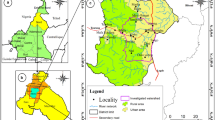Abstract
The mixing layer theory is not suitable for predicting solute transfer from initially saturated soil to surface runoff water under controlled drainage conditions. By coupling the mixing layer theory model with the numerical model Hydrus-1D, a hybrid solute transfer model has been proposed to predict soil solute transfer from an initially saturated soil into surface water, under controlled drainage water conditions. The model can also consider the increasing ponding water conditions on soil surface before surface runoff. The data of solute concentration in surface runoff and drainage water from a sand experiment is used as the reference experiment. The parameters for the water flow and solute transfer model and mixing layer depth under controlled drainage water condition are identified. Based on these identified parameters, the model is applied to another initially saturated sand experiment with constant and time-increasing mixing layer depth after surface runoff, under the controlled drainage water condition with lower drainage height at the bottom. The simulation results agree well with the observed data. Study results suggest that the hybrid model can accurately simulate the solute transfer from initially saturated soil into surface runoff under controlled drainage water condition. And it has been found that the prediction with increasing mixing layer depth is better than that with the constant one in the experiment with lower drainage condition. Since lower drainage condition and deeper ponded water depth result in later runoff start time, more solute sources in the mixing layer are needed for the surface water, and larger change rate results in the increasing mixing layer depth.







Similar content being viewed by others
References
Ahuja LR (1990) Modeling soluble chemical transfer to runoff with rainfall impact as a diffusion process. Soil Sci Soc Am J 54:312–321
Ahuja LR, Lehman OR (1982) Release of a soluble chemical from soil to runoff. Trans ASAE 25:948–953
Ahuja LR, Lehman OR (1983) The extent and nature of rainfall-soil interaction in the release of soluble chemicals to runoff. J Environ Qual 12:34–40
Ahuja LR, Ross JD, Lehman OR (1981a) A theoretical analysis of interflow of water through surface soil horizons with implications for movement of chemicals in field runoff. Water Resour Res 17:65–72
Ahuja LR, Sharpley AN, Yamamoto M et al (1981b) The depth of rainfall-runoff-soil interactions as determined by 32p. Water Resour Res 17:969–974
Bao RC, Yang JZ, Tong JX (2009) Numerical simulation and experimental verification of contamination loss due to surface runoff and subsurface water movement in the irrigated field. J Hydraul Eng 40(2):231–237 (in Chinese)
Emmerich WE, Woolhiser DA, Shirley ED (1989) Comparison of lumped and distributed models for chemical transport by surface runoff. J Environ Qual 18:120–126
Gao B, Walter MT, Steenhuis TS et al (2004) Rainfall induced chemical transport from soil to runoff: theory and experiments. J Hydrol 295:291–304
Gao B, Walter MT, Steenhuis TS et al (2005) Investigating raindrop effects on transports of sediment and non-sorbed chemicals from soil to surface runoff. J Hydrol 308:313–320
Heathman GC, Ahuja LR, Baker JL (1986) Test of nonuniform mixing model for transfer of herbicides to surface runoff. Trans ASAE 29(450–455):461
Millington RJ, Quirk JM (1961) Permeability of porous solids. Trans Faraday Soc 57(1200–1207):461
Shi XN, Wu LS, Chen WP et al (2011) Solute transfer from the soil surface to overland flow: a review. Soil Sci Soc Am J 75(4):1214–1225
Steenhuis TS, Walter MF (1980) Closed form solution for pesticide loss in runoff water. Trans ASAE 23(3):615–620, 628
Tong JX, Yang JZ, Hu BX et al (2010) Experimental study and mathematical modeling of soluble chemical transfer from unsaturated-saturated soil to surface runoff. Hydrol Process 24(21):3065–3073
Vogel T, Huang K, Zhang R et al (1996) The HYDRUS Code for simulating one-dimensional water flow, solute transport, and heat movement in variably-saturated media version 5.0. U.S. Salinity Laboratory. Research Report No.140
Wallach R, Genuchten MTV (1990) A physically based model for predicting solute transfer from soil solution to rainfall-induced runoff water. Water Resour Res 26(9):2119–2126
Wallach R, William AT, William FS (1988) Transfer of chemicals from soil solution to surface runoff: a diffusion-based soil model. Soil Sci Soc Am J 52:612–618
Walter MT, Gao B, Parlange J-Y (2007) Modeling soil solute release into runoff with infiltration. J Hydrol 347:430–437
Walton RS, Volker RE, Bristow KL et al (2000) Experimental examination of solute transport by surface runoff from low-angle slopes. J Hydrol 233:19–36
Wang QJ, Shao MA, Li ZB et al (1999) Analysis of simulating methods for soil solute transport with runoff in loess plateau. Res Soil Water Conserv 6(2):67–71, 104 (in Chinese)
Yu CR, Gao B, Muñoz-Carpena R et al (2011) A laboratory study of colloid and solute transport in surface runoff on saturated soil. J Hydrol 402(1–2):159–164
Zhang XC, Norton D, Nearing MA (1997) Chemical transfer from soil solution to surface runoff. Water Resour Res 33(4):809–815
Zhang XC, Norton LD, Lei T et al (1999) Coupling mixing zone concept with convection-diffusion equation to predict chemical transfer to surface runoff. Trans ASAE 42(4):987–994
Acknowledgments
This work is partly supported by the National Nature Foundation of China (Grant Nos. 51209187, 41530316, 91125024 and 51409192), Beijing Higher Education Young Elite Teacher Project (Grant No. YETP0653), the Open Project of the State Key Laboratory of Water Resources and Hydropower Engineering Science (Grant No. 2013B108), the Fundamental Research Funds for the Central University (Grant No. 2652015116), and the China Postdoctoral Science Foundation (2014M560627).
Author information
Authors and Affiliations
Corresponding author
Additional information
Responsible editor: Marcus Schulz
Rights and permissions
About this article
Cite this article
Tong, J., Hu, B.X., Yang, J. et al. Using a hybrid model to predict solute transfer from initially saturated soil into surface runoff with controlled drainage water. Environ Sci Pollut Res 23, 12444–12455 (2016). https://doi.org/10.1007/s11356-016-6452-4
Received:
Accepted:
Published:
Issue Date:
DOI: https://doi.org/10.1007/s11356-016-6452-4




